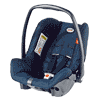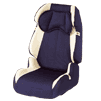 |
 |
 |
 |
Group 0+
Rear-facing infant car seats. Great for babies weighing up to 13kg (29lbs) birth to approx 12 to 15 months old, they’re lightweight, have a carry handle and can double up as baby’s first chair. They are secured in the car by an adult seat belt. |
|
 |
 |
|
Group 0+ and 1
Rear and forward-facing car seats. Use them as rear-facing seats until your baby weighs 13kg (29lbs), and as forward-facing seats when your baby weighs between 9 and 18kg (20-40lbs). They recline for extra comfort when your little one’s sleeping. |
 |
|
|
|
|
Group 1
Forward-facing car seats 9 to 18kg (20-40lbs) Approx 9months to 4 years. Suitable when your baby outgrows a 0+ seat. Most recline and have a 5-point harness. |
|
|
|
|
 |
Group 2
Forward-facing car seats 15 to 25kg (33 to 55lbs) Approx 4-6 years. Can be moved easily from car to car. Because they don’t recline they’re not suitable for younger children on long journeys. |
|
|
|
|
Group 3
Forward-facing car seats or booster seats. Recommended for children weighing 15 to 36kg (33 to 80lbs) approx 4-11 years, they make sure adult seatbelts fit properly over your little one |
 |
|
|
|
|
|
|
|
|

| |
- Babies under 18kgs need a seat with a 5-point harness for more protection than an adult seatbelt.
- Your baby should be positioned rearward facing for as long as possible until your baby reaches the maximum weight or can sit up unaided.
- Make sure you can fit the seat so it won’t move about, and adjust it every time.
- Never put your child’s car seat on a passenger seat with an airbag.
- It is now illegal for a child under the age of 12 or under 1.35 metres (approx 4ft 5ins) in height to travel without a car seat.
|
| |
All the car seats we sell are approved to United Nations Regulations ECE R44.03 |
|
|
|
 |





